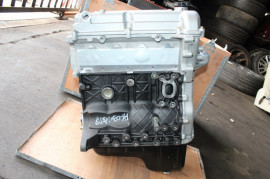Where to Find the very best Opel Corsa Engine for Substitute
Where to Find the very best Opel Corsa Engine for Substitute
Blog Article
Discovering the Inner Operation of a Compact Automobile's Engine System
As vehicle drivers, we commonly take for given the intricate processes that take place within the confines of our lorry's engine system. In this exploration of a portable vehicle's engine system, we will certainly unravel the internal workings of this mechanical harmony, losing light on the mysteries that drive us onward on our daily trips.
Burning Process Summary
The burning process in a compact automobile's engine system is a vital device that effectively transforms fuel right into energy to power the automobile. This process happens within the burning chamber of the engine, where fuel and air mix, ignite, and create regulated surges. The combustion process contains 4 main stages: intake, exhaust, power, and compression.
Throughout the intake phase, the piston relocates downward, attracting a combination of air and fuel right into the combustion chamber. The following stage, compression, entails the piston relocating upward, pressing the air-fuel mixture to increase its strength. Subsequently, in the power phase, the spark plug stirs up the compressed combination, leading to a rapid growth of gases that compels the piston pull back. This downward movement creates the power required to drive the vehicle. In the exhaust phase, the burnt gases are removed from the combustion chamber with the exhaust shutoff, preparing the chamber for the next cycle. This cyclic combustion procedure is basic to the operation of a small lorry's engine system, guaranteeing reliable power conversion for propulsion.
Piston and Cyndrical Tube Interaction

The piston's precise fit within the cylinder is essential for maintaining optimal compression and avoiding energy loss during combustion. Limited clearances in between the piston and cyndrical tube wall surfaces make certain reliable securing, enabling the piston to move smoothly without allowing gases to leak past. Proper lubrication is additionally essential to lower rubbing and use between these components, enhancing longevity and efficiency.
In addition, the style and materials used in manufacturing the piston and cyndrical tube effect engine effectiveness and sturdiness. Modern engines typically utilize lightweight yet sturdy products like aluminum alloys for pistons and cylinder linings to minimize inertia and improve thermal efficiency. On the whole, the unified interaction in between the piston and cyndrical tube is fundamental to the engine's capability and total performance.
Gas Shot System Functionality
Gas injection systems in compact lorry engines play an essential function in precisely providing fuel to the burning chamber for controlled and reliable ignition. The fuel shot system works by infusing fuel into the combustion chamber at the optimum moment throughout the engine's operation (opel corsa engine). This specific timing guarantees that the gas mixes equally with the air for proper burning, leading to boosted fuel effectiveness and reduced discharges
There are primarily two kinds of fuel injection systems made use of in compact automobile engines: port fuel injection (PFI) and straight fuel injection (DFI) PFI systems infuse gas into the consumption port prior to the intake valve, while DFI systems infuse fuel directly right into the burning chamber. Both systems have their advantages, with DFI providing far better fuel atomization and PFI offering an extra cost-effective service.
Recognizing Engine Cooling Systems
Efficient procedure of a portable automobile's engine relies heavily on the performance of its cooling systems. The cooling system in a compact lorry commonly is composed of several components functioning together to regulate the engine temperature level. Recognizing these engine air conditioning mechanisms is important for keeping the efficiency and durability of a portable lorry's engine system.

Exhaust System Components Explained
The ideal performance of a small car's engine cooling devices depends upon a complementary system called the exhaust system, which makes up various essential parts for making sure efficient exhausts and engine performance. The exhaust system includes elements such visit homepage as the exhaust manifold, catalytic converter, muffler, and tailpipe. The exhaust manifold collects exhaust gases from the engine's cyndrical tubes and paths them to the catalytic converter. The catalytic converter after that converts harmful toxins in the exhaust into much less damaging emissions prior to launching them with the muffler and tailpipe.
One essential element of the exhaust system is the oxygen sensing unit, which keeps track of the oxygen degrees in the exhaust gases to aid regulate fuel intake and ensure ideal engine efficiency. opel corsa look at more info engine. Additionally, the resonator may be existing in some exhaust systems to lower noise levels. On the whole, the exhaust system plays a vital role in preserving engine performance, reducing hazardous discharges, and making certain a quieter driving experience for compact car owners

Conclusion
Finally, the portable vehicle's engine system is a complex combination of parts that function together to help with the combustion procedure, transform gas right into energy, and remove waste gases. Comprehending the internal operations of the engine system, including the piston and cylinder interaction, fuel injection system, engine cooling systems, and exhaust system elements, is critical for maintaining optimal performance and effectiveness of the car.
The burning procedure in a small automobile's engine system is a critical mechanism that efficiently converts fuel into power to power the lorry.Gas shot systems in compact vehicle engines play a crucial role in precisely providing fuel to the combustion chamber for controlled and reliable ignition.There are primarily two types of fuel shot systems made use of in portable lorry engines: port gas shot (PFI) and straight gas injection (DFI) Understanding these engine cooling mechanisms is important for keeping the efficiency and durability of a small vehicle's engine system.
The optimum performance of a small car's engine cooling mechanisms advice depends on a corresponding system understood as the exhaust system, which comprises numerous crucial parts for making sure effective emissions and engine efficiency.
Report this page